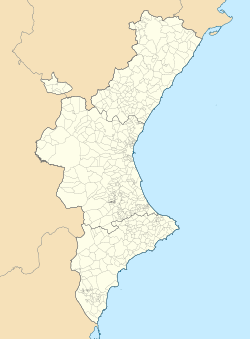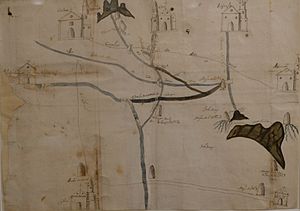Callosa de Segura facts for kids
Quick facts for kids
Callosa de Segura
|
|||
|---|---|---|---|
|
|||
| Country | |||
| Autonomous community | |||
| Province | Alicante | ||
| Comarca | Vega Baja del Segura | ||
| Judicial district | Callosa de Segura | ||
| Area | |||
| • Total | 25 km2 (10 sq mi) | ||
| Elevation | 27 m (89 ft) | ||
| Population
(2018)
|
|||
| • Total | 18,864 | ||
| • Density | 755/km2 (1,950/sq mi) | ||
| Demonym(s) | Callosinos | ||
| Time zone | UTC+1 (CET) | ||
| • Summer (DST) | UTC+2 (CEST) | ||
| Postal code |
03360-03365
|
||
| Official language(s) | Spanish | ||
Callosa de Segura is a town in Spain. It is located in the Valencian Community. This town is known for its beautiful mountains and historic buildings. It is a traditional Spanish-speaking place. You can find it north-west of Orihuela.
Getting to Callosa de Segura is easy. You can use the A-7 (E15) motorway, exit 79. Or, take the AP-7 motorway, exit 733. It is only 30 minutes from Alicante and Murcia airports. The beach at Guardamar is also just 30 minutes away. The town is dominated by the Sierra de Callosa mountains. Some houses even climb up the mountain slopes. Farmers grow crops on terraced fields high up.
Contents
Exploring Callosa de Segura's Main Sights
Callosa de Segura has many interesting places to visit. These sites show the town's rich history.
The Saint Roque Hermitage
This special chapel sits high above Callosa de Segura. It looks like it is guarding the town. Above the hermitage, you can see the castle of Callosa. The hermitage was built between 1579 and 1798. It honors Saint Roque, who is the patron saint of Callosa de Segura. People say Saint Roque appeared on the very spot where the hermitage now stands.
Saint Martin's Church
The Saint Martin's Church is another important building. It dates back to the 16th to 18th centuries. The church has a beautiful blue decorated dome. Inside its chapel, you can find amazing gold artwork. These pieces were created by an artist named Miguel de Vera. The older part of town, just below the hermitage, has very narrow streets.
Callosa de Segura History Museum
The old town slaughterhouse was built in 1929. It has been renovated and is now a history museum. This museum tells the story of Callosa de Segura. It has four main sections for visitors to explore.
Archaeological Museum
This section is called the Antonio Ballester Ruiz Archaeological Museum. Here, you can see artifacts from the town's early history. These include funeral items, urns, and ancient tools. There are also coins, glassware, and ceramics. You can find items from the Neolithic Era. There are also pieces from the Argaric and Iberian cultures. Even artifacts from the Roman occupation are on display.
Hemp and Agricultural Museum
This part of the museum shows the history of hemp production. Hemp was a very important part of the town's economy. You can see samples of the many products made from hemp. This section explains how hemp helped the town grow.
Holy Week Museum
The Holy Week Museum (Santa Semana) displays special items. It contains thrones and images used in the Holy Week celebrations. These beautiful pieces were made by artists like José Noguera, Hurtado Carré, and José Hernández.
Fiesta Museum
The Fiesta Museum celebrates the town's festivals. It showcases the traditions and joy of Callosa de Segura's local parties.
Callosa de Segura's Economy
The town's economy mainly depends on agriculture and manufacturing. Growing crops is a big part of their work. Making products is also very important. One key product is cordage made from hemp. This means ropes and other items made from hemp fibers. This industry has been a significant part of Callosa de Segura's economy for a long time.
See also
 In Spanish: Callosa de Segura para niños
In Spanish: Callosa de Segura para niños







